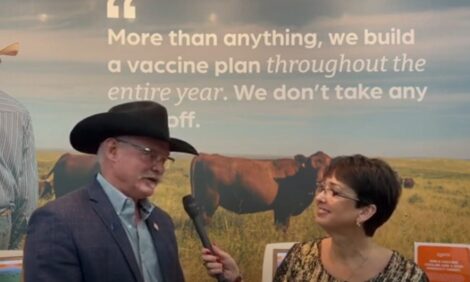



Tyson’s McConnel describes sustainability challenges for global beef industry
The farmer and rancher's voice is critical to progressEditor’s note: The conversation with Ian McConnel was edited for brevity.
Ian McConnel, director of international sustainability for Tyson, as well as the president for the Global Roundtable for Sustainable Beef (GRSB), spoke to The Cattle Site’s Sarah Mikesell at the Global Conference for Sustainable Beef in Denver, Colorado, USA in November.
What are the biggest sustainability challenges that you see for the global beef industry?
The biggest challenge, a challenge we've been discussing today here at the Communicator’s Summit during the first day of our conference, is how do we actually communicate the progress, the efforts and the work that's happening already throughout the beef supply chain, but particularly on the ground with the farmers and ranchers, to the consumer who’s beginning to ask more and more questions. As a company that wants to sell to customers today, and to the customers of tomorrow, we need to be able to begin to take those good news stories and tell them to consumers, as well as drive change in the places we need change. And I think that's another challenge. How do we own up to some of those areas we want to improve and drive change in those places too?
How is the GRSB able to address some of these challenges?
We are bringing people together and finding what the solutions are. These are big challenges that we as food companies can't do on our own. We need to hear from producers about what the solutions are around how we work together; we need to hear from the finance sector about how we might invest in and drive change through finance; we need to hear from companies that are talking to customers around what are they hearing but also have them armed with the stories and information to talk to consumers. Then we need to package all that information together and demonstrate progress towards our global goals. So, bringing people together is what we do – it’s our bread and butter as the GRSB –to find those solutions. And we're making some big progress.
What are GRSB’s goals?
We've got three goals currently - one on climate to reduce by 30% our global warming impact. Our animal welfare goal is around providing animals with a life worth living. Then, we've got a net positive nature goal, which is about demonstrating that the beef industry plays a net positive role in nature. The three goals are written to be relevant to the beef industry globally - so in southern Africa to Europe to Argentina, Brazil, the US, Canada, Australia, New Zealand – we’ve got roundtables all around the world. Those goals become a really unifying set of ambitions that we're now working on. Right now, we're at the point where we're trying to create baselines and data sets that will enable us to report progress in future years.
How different is beef production around the world?
One of the real challenges we faced in writing our GRSB goals is the challenges we see in the middle of Kansas are very different from what we see in southern Argentina, Germany, Poland or in Ireland. So bringing people together to understand, and I think it was useful also to think where do we want to be in five years rather than where we are now. What we saw was an alignment around what we want beef to be part of the thriving food system and a recognized and trusted part of the thriving food system. To do that, we're going to need to help build consumer trust, by sharing values with the consumer and by ensuring we're aligning our values as an industry with what the consumer policymakers in the finance sector want. Our goals allow us to start talking with one language to all those markets.
Who is represented in the GRSB?
We have a lot of different constituencies; we have processors, retailers, allied services to animal health companies and finance. By far our largest constituency is the production sector - either representative bodies or even ranches and farming businesses themselves, which really provides so much richness to the conversation around how we do sustainable beef production, rather than just talking about selling it and financing it.
The producer offers such an important voice. It's very easy for us to become isolated as sustainability professionals, who sit around very progressive people. Actually making sure we're grounded in the reality of what's happening on the ranch and understanding that a rancher these days is a businessman, a veterinarian, a mechanic, and we're trying to add something else to that. So how do we ensure that there are rewards for them in this as well?
What kind of role does GRSB play for Tyson Foods?
For us at Tyson Foods, we need to be able to engage in a broader sustainability discussion. We need to learn from others. We also need to make sure that we're headed in the same direction as others. I think one of the biggest risks is that companies like us head in a direction different than others and then we leave ranches sort of stuck in the middle. We need to make sure we're working in one direction. We also just learn a lot – we learn a lot that helps us as a company from the farmers in the room, from the financers, from our customers, and from people who aren't our customers but sit further down the supply chain that happened to be in this room. It adds a lot of value to our business, and hopefully, by coming in as a fairly large processor, we can add value to the GRSB as well. And we're part of the poultry roundtable as well, and some of the lessons we learn, we can apply right across the business because the principles of sustainability are shared.
Learn more about the Global Roundtable for Sustainable Beef.



